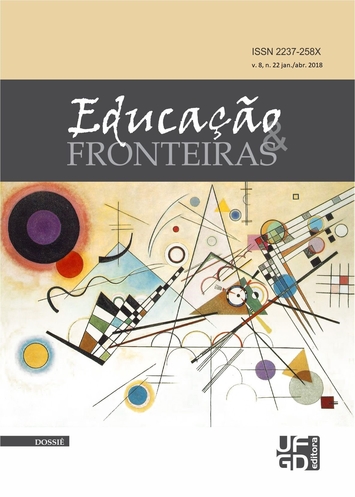Remembering to preserve: storytelling as an instrument of heritage education
DOI:
https://doi.org/10.30612/eduf.v8i22.9054Keywords:
Patrimonial education. Rememoration. Storytelling.Abstract
Perceiving the individual from the interaction that he establishes with his environment is of great importance for the directions of the new pedagogical proposals that are intended to be implemented in the country. However, this generated a series of doubts about which pedagogical practices to use to meet this need to include socio-historical discussions, in a particular way, in the classroom - taking into account the Brazilian cultural diversity. The situation becomes even more complex when one observes that, according to the hypothesis raised, there is a dissociation of formal education from the cultural heritage of the people to which the teaching is directed. From this, the objective is to reflect on the importance of Cultural Heritage in teaching-learning relations and to focus the work of remembrance, based on classroom storytelling practices, as an important tool to be explored in the appreciation and preservation of the local culture. For this purpose, the methodology was exploratory and descriptive. Among other issues, it was noted that the school has an important role in mediating the policies of preservation of the Cultural Patrimony with the individuals holding the cultures to be recognized and preserved.Downloads
References
ALBERTI, Verena. Manual de História Oral. Rio de Janeiro: FGV, 2005. Disponível em: http://books.google.com.br/. Acesso em 08/03/2017.
AZEVEDO, Ricardo. Formas literárias populares e formação de leitores. In: BARBOSA, Márcia H. S.; RETTENMAIER, Miguel; RÖSING, Tânia M. K. (Org.). Leitura, identidade e patrimônio cultural. Passo Fundo: UPF, 2004.
BENJAMIN, Walter. O narrador: considerações sobre a obra de Nikolai Leskov. In: ______. Magia e técnica, arte e política: ensaios sobre literatura e história da cultura. São Paulo: Brasiliense, 2012. p. 213-239.
BRASIL. Presidência da República. Constituição da República Federativa do Brasil 1988. Disponível em: http://www.planalto.gov.br/ccivil_03/constituicao/constituicaocompilado.htm. Acesso em 08/03/2017.
BRASIL. Presidência da República. DECRETO-LEI Nº 25, DE 30 DE NOVEMBRO DE 1937. Disponível em: http://www.planalto.gov.br/ccivil_03/decreto-lei/Del0025.htm. Acesso em 07/03/2017.
BRASIL. Decreto-Lei nº 5.692, de 11 de Agosto de 1971. Fixa Diretrizes e Bases para o Ensino de 1º e 2º graus e dá outras providências. Coletânea da Legislação Estadual de Ensino, Curitiba, Secretaria Educacional do Estado do Paraná (SEEC) – Fundepar, p. 589.
CARVALHO, J. S. F. de. Construtivismo: uma pedagogia esquecida da escola. Porto Alegre: Artmed Editora, 2001.
DIEHL, Astor. Cultura Historiográfica: memória, identidade e representação. Bauru: EDUSC, 2002.
DUARTE, N. Vigotski e o “aprender a aprender: crítica às apropriações neoliberais e pósmodernas da teoria vigotskiana. Campinas: Autores Associados, 2001.
FARIA, Hamilton; GARCIA, Pedro. Arte e Identidade Cultural na Construção de um Mundo Solidário. In: ______. O reencantamento do mundo: arte e identidade cultural na construção de um mundo solidário. São Paulo: Polis, 2002.
GAGNEBIN, J. M. História e narração em W. Benjamin. São Paulo: Perspectiva, 1994.
HALBWACHS, M. A memória coletiva. São Paulo: Centauro, 2006.
HORTA, Maria de Lourdes Parreiras. Guia Básico de Educação Patrimonial. Brasília: IPHAN/Museu Imperial, 1999.
KLEIN, L. Construtivismo piagetiano: considerações críticas a concepção de sujeito e objeto. In: DUARTE, N. (org.). Sobre o construtivismo. Campinas: Autores Associados, 2005, p.63-86.
LEMOS, Carlos A. C. O que é patrimônio histórico. São Paulo: Editora Brasiliense S.A., 1981.
RIBEIRO, Sandra Bernardes. Memória, cidadania e gestão do patrimônio cultural. São Paulo: Annablume, 2005.
SANTOS, Myrian dos. O pesadelo da amnésia coletiva: um estudo sobre os conceitos de memória, tradição e traços do passado. Revista Brasileira de Ciências Sociais. São Paulo, n. 23, 1993, p. 70-85.
SARTRE, Jean-Paul. O ser e o nada: ensaio de ontologia fenomenológica. Trad. Paulo Perdigão. Petrópolis: Vozes, 1997.
Secretaria de Educação Fundamental. Parâmetros Curriculares Nacionais: introdução aos parâmetros curriculares nacionais (v. 1). Brasília: MEC/SEF, 1997. Secretaria de Educação Fundamental. Parâmetros Curriculares Nacionais: apresentação dos temas transversais, ética (v. 8). Brasília: MEC/SEF, 1997.
SHEDLOCK, Marie. Da introdução de A arte de contar histórias. In: GIRARDELLO, Gilka. (Org.). Baús e chaves da narração de histórias. Florianópolis: SESC, 2004.
SILVA, Flávia Gonçalves da. Conceitos de Vigotski no Brasil: Produção divulgada nos cadernos de pesquisa. Cadernos de Pesquisa. v. 34, n. 123, p. 633-661, set./dez. 2004.
SILVEIRA, Éder da Silva. História Oral e Memória: a construção de um perfil de HistoriadorEtnográfico. Ciência e conhecimento – revista eletrônica da Ulbra São Jerônimo – vol. 1, 2007. Disponível em: http://www.cienciaeconhecimento.com.br/. Acesso em 08/03/2017.
SIMONSEN, Michele. O Conto Popular. São Paulo: Martins Fontes, 1987.









